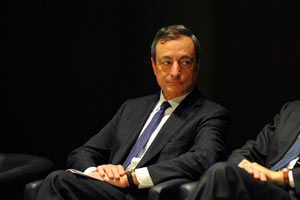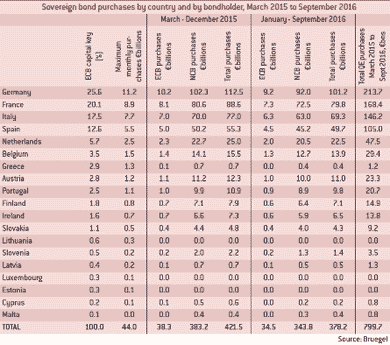The European Central Bank QE (quantitative easing) regime is officially in full swing.

European Central Bank data released last Friday indicated as much. The sovereign bond-buying program began March 9. And in less than two weeks, Eurozone central banks had already purchased 26.3 billion euros ($28.9 billion) worth of these bonds.
At the same time, economic indicators seem to point toward a recovery. Markit's Purchasing Managers' Index data released yesterday (Tuesday) revealed Eurozone businesses are at their most optimistic in four years. The EURO STOXX 50 Index - the leading blue-chip index for the Eurozone - is up 21% in 2015. And what's more, it's at nearly seven-year highs.
Even the beleaguered euro has stepped off a bit from the precipice of euro-dollar parity. This morning, it was trading at $1.0967. This is after falling to $1.0484 on March 15.
This positivity in Eurozone markets all seems unwarranted. The Greek debt crisis, perhaps the biggest problem facing the Eurozone right now, doesn't have a solution. And Eurozone QE was never built to address it.
Eurozone QE is a "confidence trick," Financial Times columnist Wolfgang Münchau wrote on Sunday. Positive economic data came as a result of falling oil prices, which provided a windfall to the Eurozone, the world's largest net importer of oil and gas. And those benefits are easily wiped away by any surge in oil prices.
It's hard to actually be bullish on the Eurozone even with economic data providing a thin veneer of Eurozone confidence. The situation in Greece is worse and more contentious than it has ever been. And QE, a policy aimed at bringing on a recovery, is hardly what it's cracked up to be.
The benefits of Eurozone QE are illusory. This surge in Eurozone optimism is built on a false premise that a largely impotent policy will be the saving grace for a struggling Eurozone.
But a closer look at how Eurozone QE works should shatter all those illusions...
Why European Central Bank QE Won't Fix Anything
ECB President Mario Draghi announced QE in January because he had no other options. Deflation was setting in and he couldn't get caught sitting on his hands.
In QE, a central bank will start by buying up a commercial bank's sovereign government bonds. The central bank will then credit the bank's reserve account for the face value of those assets. For a bank, it's really nothing more than an asset swap. Assets stay the same. But reserves increase and so too does a bank's lending capacity.

The problem, however, is that Eurozone QE won't spark inflation on its own. It's only inflationary if commercial lenders actually lend out these euros flooding their balance sheets to households and firms.
Granted, European Central Bank lending surveys show loan demand is picking up across the Eurozone. But it's still too early to say whether this is built on the foundations of an actual recovery or fragile confidence in a recovery that has yet to materialize.
QE is nothing without lending. All it does is leave these commercial banks with excess reserves. And those reserves would actually lose money at the -0.2% interest rate imposed on ECB deposit facilities.
But Eurozone QE is even more complicated than that. Draghi was up against fierce German opposition to any monetary policy decision that could be interpreted as financing the debts of European Union member countries. This tied the ECB's hands to deliver on an even more impotent QE policy.
In this program, 88% of sovereign bond purchases will come from member central banks buying their own debt. The other 12% is European Central Bank buying purchases. Of the 50 billion euros ($54.9 billion) the ECB has pledged to buy a month, 6 billion euros ($6.6 billion) will be ECB purchases and the other 44 billion euros ($48.3 billion) will fall on national central banks.
Purchases will be in proportion to the capital key. The capital key the amount each member country pays into the ECB for EU membership. And that paid-up capital is proportional to the size of the country's population and GDP to the EU. So in this case, Germany will make up 25.6% of bond purchases. But a country like Malta will only make up 0.1% of purchases.
This was to ensure that risk-sharing was kept to minimum, all at the urging of Germany. Under this scheme, member countries wouldn't have to help foot the bill for another member's default.
Also through this program, purchases are confined to no more than 25% of a single bond issue. That's because at 25%, the Eurozone would be considered to hold a "blocking minority." This means the ECB could block any debt restructuring should a Eurozone member default. The ECB doesn't want to give itself this ability, lest it be accused of making financing decisions for an individual member's debt, according to the Bruegel Policy Contribution.
The ECB is also forbidden from holding 33% of any one Eurozone country's total debt.
So what does this all mean for the Eurozone recovery and the current surge in optimism?
The Problem European Central Bank QE Can't Solve
[epom key="ddec3ef33420ef7c9964a4695c349764" redirect="" sourceid="" imported="false"]
QE is ineffective enough when banks aren't lending, strict limits aside. Bruegel projected that between March 2015 and September 2016 - the tentative schedule for bond purchases - eligible debt purchases would amount to only 799.7 billion euros ($855.7 billion). This is far short of the 1.1 trillion euro ($1.2 trillion) pledge.
Debt eligibility requirements also preclude Greece, the weakest Eurozone country, from QE purchases until August. Through the Securities Market Programme, which ran from May 2010 to September 2012, the Eurosystem has purchased enough Greek debt that its holdings already eclipse the 33% mark. Greece will have to wait until some of those debts mature before it's even part of the QE equation.
Peeling back these numbers show the reality of Eurozone QE. It won't solve what ails Europe the most right now: Greece.
Greece is hopping from one Band-Aid to the next in trying to pay back its debts. Greece's creditors - the European Union and the International Monetary Fund - have been extending and pretending for five years now. They continue to impose austerity conditionality that the Greek public has rejected. And this has all been for rescue packages that have so far done little but add more of a debt burden to a country that's already insolvent.
Greece can do one of two things. It can default and raise the specter of Eurozone moral hazard. Why would a member country even try to adhere to fiscal discipline if the Eurozone is content to let one of its members default?
Or it can exit the euro. This would jeopardize more than 60 years of planning by European elites - elites who had, and still have, lofty ambitions of turning Europe into a cohesive economic bloc capable of challenging global dollar hegemony.
Exactly How Big Is the Greek Debt Crisis? The country is 323 billion euros in debt ($352.7 billion) - more than 175% of its GDP. These four charts help to put that number into perspective...


